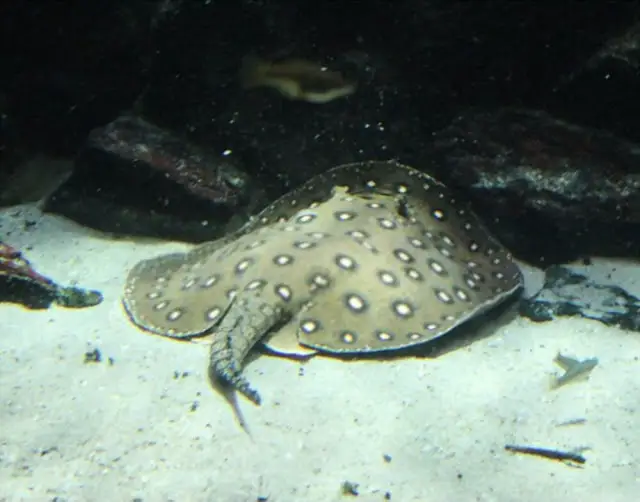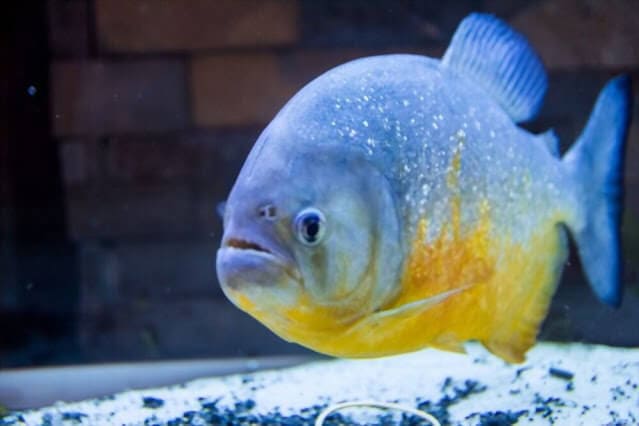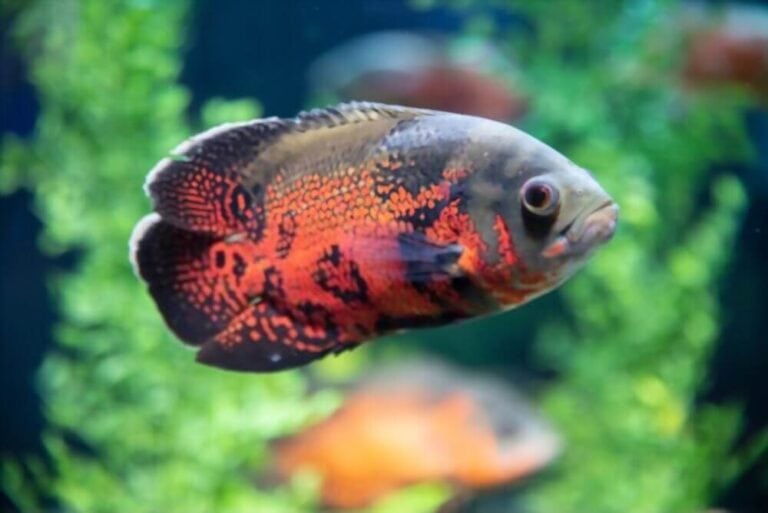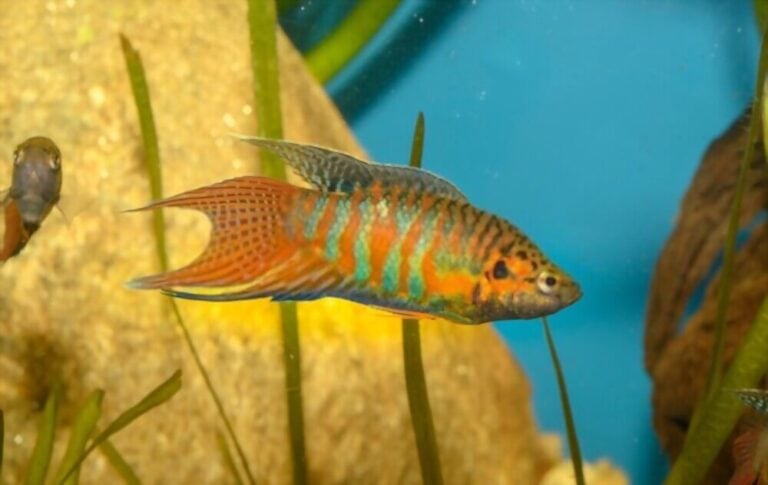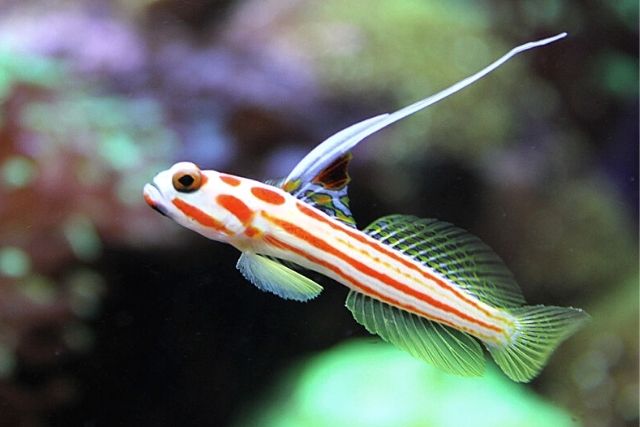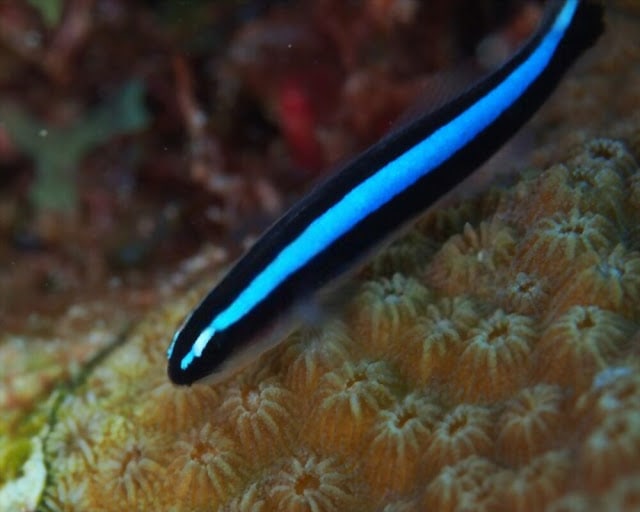Dwarf Angelfish Care Guide: Size, Reef Safe, Diet, Tank Size, Tank Mates
The dwarf angelfish include more than 30 species. Almost all species live in the coral reefs of the Indo-pacific. Cherub pygmy angelfish and Flame black pygmy angelfish live in the tropical western Atlantic.
The way of life of dwarf angelfish is that they live in groups such as males with several females, hidden under coral reefs. The dwarf angelfish feed mainly on algae, but they also eat small crustaceans.
We will discuss and give a complete care guide for freshwater and Saltwater Dwarf angelfish including, diet, tank size, tank mates, and other requirements.
Dwarf Angelfish Freshwater
Pterophyllum leopoldi, also referred to as the dwarf angelfish, teardrop angelfish, or roman-nosed angelfish is a freshwater dwarf angelfish species native to the Amazon, Essequibo River, and Rupununi River.
P. leopoldi freshwater dwarf angelfish is different from other members of the Pterophyllum genus. Freshwater P. leopoldi dwarf angelfish has not a pre-dorsal notch, and they have black blotch at the dorsal.
Size of Freshwater Dwarf Angelfish
P. leopoldi reaches up to 5 cm in length and is the smallest freshwater dwarf angelfish with a highly aggressive temperament. This is very similar to P. dumerilii. Due to this reason, this species is misidentified when it is imported into the breeder tank.
Dwarf Angelfish Saltwater
Centropyge belongs to the group of highly valued dwarf angelfish. These are saltwater dwarf angels. They are generally much more accessible fish for the average hobbyist because they have fewer maintenance problems than large angelfish.
It is a small species with very striking coloration. Its base color is orange with blue-violet flanks and tail fin between yellow and transparent. The saltwater aquarium plants will add color to the beautifulness of the tank
This last feature distinguishes it from the Brazilian dwarf angelfish since it presents a blue-colored tail fin. Its coloration hardly varies between the juvenile state and the adult state.
It is a very resistant species with little resistance between its species in aquariums large enough not to harm invertebrates. Yes, it can nibble on the coral reefs but without causing severe damage. With other species, it is indifferent.
Size of Dwarf Angelfish Saltwater.
Size of Centropyge dwarf angelfish of salt water is Up to 7 cm.
It does not require bulky tanks if you have to keep it alone in the tank. Species indicated for medium or small tanks.
Before introducing our dwarf angels into the aquarium, we must ensure that the aquarium should be well maintained and populated by a good colony of filamentous algae.
These algae will play an essential role in the fish’s acclimatization since it will feed on them while it gets used to the new feeding.
Dwarf Angelfish Reef Safe.
Whether dwarf angelfish is reef safe or not depends on the species. Some are reef safe, and others are not.
Such as the cherub dwarf angel is one of the most reef safe. Bicolor, the lemon zest dwarf angel, is a more aggressive dwarf angel and not necessarily a good resident for a reef tank, and it is not reef safe.
Dwarf Angelfish Care
It is recommended to keep them in an aquarium with maintained conditions and proper care. You have to provide food them time to time and clean the tank regularly as given above.
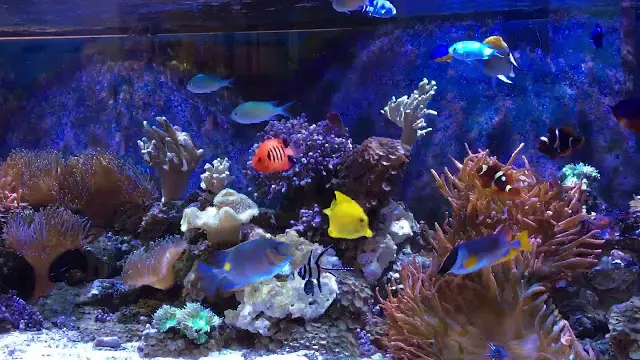
Care of dwarf angelfish is lie in the medium category. To take care of dwarf angelfish, you should maintain the following water parameters as per the described value.
- pH: 8.1-8.4
- Temperature: 72°F-82°F (22°C-28°C)
- Specific gravity: 1.020-1.025
- Carbonate hardness (dKH): 8-12°
Keeping dwarf angelfish in tank two factors is very important to the tank’s size and quality of water tank.
They are bred in captivity, but it is challenging because they are aggressive with members of their species, and also, the larvae are smaller.
If a group is promoted from a tiny scale together, then a hierarchy could be formed, and the largest and most important one can become a male. If the two angelfish are constantly fighting, it may be because they are both males, and they need to be separated.
Coral Beauty Angelfish Care Guide
Feeding Frequency
Feeding can be dependent on the size of the tank. Generally, they should be fed 2 to 3 times a day, with less in a tank with very natural algae sources. But if it is a larger tank with more algae to hunt for them, feed 1 to 2 times a day.
Eggs should be hatched for about 20 hours and will survive on the yolk sac for 2-3 days, at which time microalgae need to be fed.
Eggs are carried in the water, and it is recommended to use a higher breeding pond for better results. Feeding larvae is one of the most challenging aspects of feeding these species.
Dwarf Angelfish Diet
Dwarfs angelfish are an omnivore, but their diet consists mainly of algae. They required natural algae to grow in the aquarium.
What Do Guppies Eat? ( Diet Guide)
You need to include seaweed or spirulina to complete their diet with protein sources. That fish in its natural habitat consumes worms, crustaceans, and sponges as protein sources. They respect invertebrates, excludes corals.
Usually, provide food to dwarf angels 2 to 3 times per day, and providing important food is necessary.
It will generally respect the invertebrates in the tank. However, to make sure, it may be a good idea to add pieces of clam, shrimp, or mussels to their diet. They will gladly accept frozen food readily available in any aquarium trade, especially krill, Mysis, and shrimp.
They should not be given live worms as they can introduce deadly bacteria into the aquarium.
It is recommended to feed the dwarf angelfish at utterly night while sleeping in the water center. Dwarfs inhabit the bottom of the aquarium, and when the angelfish is inactive, the food goes down completely.
Dwarf Angelfish Tank Size & Setup
Appropriately sized tank, minimum 55 to 65 liters with live rock and proper algae growth is recommended. For multiple dwarf angelfish, tank size should be at least 25 gallons needed.
Guppy Tank Guide (Tank Requirements & Tank Mates)
The decoration should be formed by a vertical rock wall covering the aquarium’s back wall so that the animals feel safe. Despite being fish resistant to the impoverishment of aquatic conditions, they are very susceptible to diseases.
Therefore, if the water parameters vary more than those indicated, our fish will have a good chance of getting sick.
It is an excellent idea to provide a large number of hiding places in your tank, as it can help them feel better and safer. The second benefit of giving live rocks is that they can be used as a food source to graze between meals.
They should receive a complete and balanced diet but do not provide more food than required.
Temperature & Tank Condition
To keep these fish properly, the environment must be at least 25 degrees, so you need to choose the right aquarium with a heater. They are the fish that regularly swim, so it is not advisable to put them in fish tanks less than 25 gallons or more.
Some of the aquarium water needs to be changed at least monthly but always follow clearly defined instructions.
The filter should be of good quality, but the power should not be too high to avoid water flow. They are usually not aggressive. So they can live with other fish, but you have to keep the enclosure well to avoid controversy or injury.
Dwarf angels like to have plants in the aquarium. It is essential to replace 20% of the water every week. It is necessary to strictly follow the manufacturer’s instructions for the complete cleaning of the aquarium.
Dwarf Angelfish Tank Mates
Tankmates of dwarf angelfish depend on the species. Some dwarf angelfishes are very aggressive and other or not.
Usually, dwarf angelfish is highly aggressive until death in the small aquariums. Two males dwarf fight with each other until death.
Unless the aquarium size is not more than 75 liters and there are not enough hiding places, dwarf angelfish cannot keep together with Centropyge angelfish.
Summarize
Resplendent pygmy angelfish lives in the isolated on the island of Ascension in the Atlantic. A dwarf angelfish of the African east coast areas and Oman’s region, Yemen are orange-black pygmy angelfish.
Features of the dwarf angelfish, depending on the species, are 6 to 19 centimeters long. Like all angelfish, they have the typical thorn at the bottom of the gill cover and are high black and flattened on the side.
The dorsal fin is continuous. Most species are colorful, but there are also darkly colored representatives, such as midnight pygmy angelfish. There is no different coloring of the juvenile fish as in many other angelfish in the dwarf angelfish.
The dwarf angelfish is one of the eight angelfish species. They are divided into subgenus, Centropyge, and Xiphypops. So far, 33 species have been described. Since many live very hidden, new species could still be discovered.
On the other hand, some species are very similar, and it could be local color variations of already known species. Hybrids between different species have also been found in the wild.
These crosses could also be described as new species. Discoveries are primarily made at greater depths between 50 and 150 meters.
Dwarf angelfish are more suitable for keeping in saltwater aquariums. Even in freedom, they have only a few square meters of territory and adapt better to the aquarium’s cramped conditions.
Since they are hermaphrodites, the pair’s combination is not a problem if you buy two whose size is significantly different. The tendency of many specimens to nibble on the corals can be problematic.
This is different for the individual and does not depend on species. A coral-eating angelfish can destroy the stock of an aquarium in a few days. Dwarf angel is awake, and usually, they do aware of their surroundings.
FAQs
Can dwarf angelfish be kept together?
Since the dwarf angelfish are hermaphrodites, the combination of the pairs is usually not a problem. If you buy two animals, be sure to take a larger and a smaller fish. The smaller animal becomes a female, while the larger one becomes a male.
Most dwarf emperors don’t go to corals. But unfortunately, you can’t always rule it out.
Dwarf angelfish are generally suitable for aquarium life.
Reef structures made of living stones with natural algae growth are an essential source of food for them. Also, caves in the stone structures are the right hiding places for dwarf emperors.
How big do dwarf angelfish get?
Depending on the species, they are six to nineteen centimeters long. Like all angelfish, they have the typical thorn at the bottom of the gill cover and are high back and flattened on the side.
What do dwarf angelfish eat?
Dwarfs angelfish eats mainly algae, insects, water worms, mealworms, small live fish, and pellet food. There are many kinds of dwarf angelfish, and the size is very different.
So, the choices of food for different species of dwarf angels are also different. The small breed can also be domesticated to pellet feed and also on algae.
What is the smallest angelfish?
P. leopoldi angelfish is the smallest among all angelfish species, and they are up to 5 cm in length and an aggressive temperament.
Compared to large angelfish, small angelfish are more likely to be kept in home aquariums. They do not need much space, nor do they have to worry about attacking other fish.
Like large angelfish, they have colorful coats, some of which are even brighter from Japan’s southern coast to the Caribbean. Some varieties are located in very well-known geographical locations, such as Easter Island, Hawaiian Islands, Christmas Island, etc.
